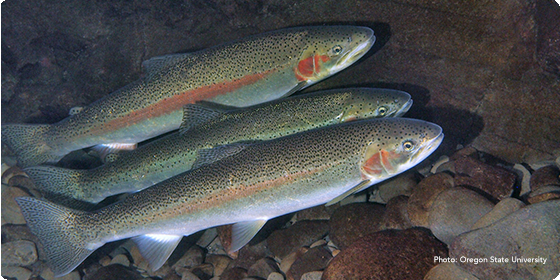
In November, environmental groups requested the Ninth Circuit Court of Appeals overturn a district court decision and require the Santa Maria Valley River Water Conservation District to release water from the Twitchell Dam to protect the endangered steelhead trout. Earlier this year, a U.S. district court found that securing water release for the steelhead trout was not a permissible purpose under the 1954 operating statute for the Twitchell Dam. The Santa Maria Water Conservation District is the defendant in the case, and the State of California filed in amicus brief in support of securing water release for trout conservation. Dams play an integral role in the current management of water use and energy production, but can also lead to negative habitat and ecosystem damage. This case illustrates the ongoing struggle of managing dams to provide for many competing uses.
The Twitchell Dam was constructed on the Cuyama River in 1958. Generally, the water is managed to provide flood control and recharge groundwater aquifers. The Cuyama River is a tributary of the Santa Maria River and supports habitat for many aquatic species such as the endangered Southern California steelhead trout. In 1997, the steelhead trout were listed as endangered under the Endangered Species Act (ESA). Environmental groups argue the failure to release sufficient water from the Twitchell Dam is decreasing downstream water flow, and the steelhead trout are not able to migrate to the Pacific Ocean and their spawning habitat. The central issue in this case is whether the Twitchell Dam must be managed to protect the habitat of the endangered steelhead trout.
The ESA was enacted in 1973 for the purpose of protecting and recovering endangered species and their ecosystems. ESA Section 9 prohibits the “take” of endangered species. Under the statute, take is defined to mean harm, harass, pursue or habitat modification which can kill or injure wildlife. The environmental groups argue that the dam management amounts to an illegal “take” of the steelhead trout.
Dams are managed by operating statutes enacted by Congress. In the statute, Congress generally sets permissible water uses and established priorities for operation. Congress set operating priorities for the Twitchell Dam in Public Law 774 in 1954. Therefore, the district court had to determine whether, under those statutory operating priorities, the dam must be managed to provide water for the protected steelhead trout.
The district court found the Twitchell Dam operation was not a violation of the ESA. The court determined that the operating purposes under Public Law 774 were clear and did not permit water release for steelhead trout. Therefore, operation of the Dam was not a violation of the ESA because the agency had no authority to release water for steelhead trout. On appeal, environmental groups and the State argue the district court overlooked California laws that require dam operators to allow adequate water to protect fish. At this time, the proceedings of the case are ongoing. The parties have submitted briefs, but an oral argument schedule has not been set. The decision in this case may provide additional clarity on how dams should be managed to provide for endangered species and competing uses.












